US President Donald Trump’s visit to Riyadh marked a historic turning point—one destined to be etched into the annals of diplomacy as a moment of lasting consequence for the Middle East and the formation of a new global order. Its significance lay in the breadth of accords it produced—spanning economic, defence, and scientific domains, and extending to groundbreaking agreements in artificial intelligence.
Yet the most striking development came with Trump’s unexpected announcement: the lifting of long-standing US sanctions on Syria and the restoration of diplomatic relations. This was swiftly followed by a landmark meeting with Syrian President Ahmed al-Sharaa, held under the patronage and with the backing of Saudi Crown Prince Mohammed bin Salman. The message was unmistakable: Damascus’s exit from the isolation long imposed by Washington now runs through Riyadh—a capital whose regional and global weight has become indisputable.
The Riyadh summit marked a definitive break with decades of American sanctions on—and political isolation of Syria— ostensibly in response to the former regime’s repression of its people, its antagonism towards neighbouring states, and its entrenchment in divisive regional alliances. The fall of the Assad regime at the end of last year was not merely a political transition; it was a strategic shift of historic proportions—arguably the most consequential event in the Middle East in recent decades.
Unlike Iraq, where the fall of Saddam Hussein in 2003 paved the way for the rise of the Iranian Crescent, the collapse of Assad’s rule in 2024 delivered a severe blow to that very arc of influence. And just as Syria’s alliance with Tehran had once tilted the regional balance towards the so-called “Axis of Resistance,” its return to the Arab fold now signals a profound recalibration of regional power.




